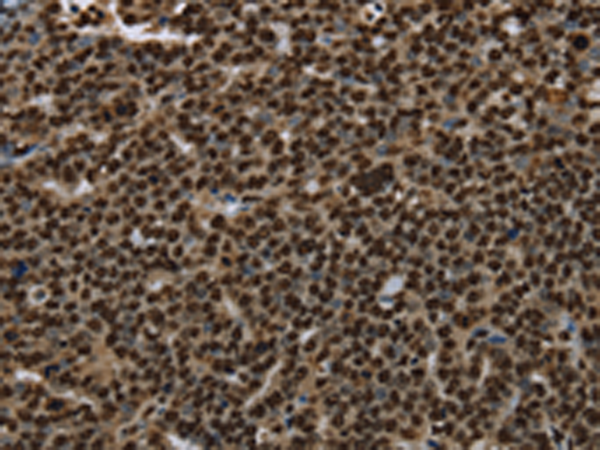


| WB | 咨询技术 | Human,Mouse,Rat |
| IF | 咨询技术 | Human,Mouse,Rat |
| IHC | 1/50-1/200 | Human,Mouse,Rat |
| ICC | 技术咨询 | Human,Mouse,Rat |
| FCM | 咨询技术 | Human,Mouse,Rat |
| Elisa | 1/2000-1/5000 | Human,Mouse,Rat |
| Aliases | LANPL; LANP-L |
| WB Predicted band size | 31 kDa |
| Host/Isotype | Rabbit IgG |
| Antibody Type | Primary antibody |
| Storage | Store at 4°C short term. Aliquot and store at -20°C long term. Avoid freeze/thaw cycles. |
| Species Reactivity | Human, Mouse, Rat |
| Immunogen | Synthetic peptide of human ANP32E |
| Formulation | Purified antibody in PBS with 0.05% sodium azide and 50% glycerol. |
+ +
以下是关于ANP32E抗体的3篇参考文献及其摘要:
---
1. **文献名称**:*ANP32E Is a Histone Chaperone that Removes H2A.Z from Chromatin*
**作者**:Obri, A., Ouararhni, K., et al.
**期刊**:*Molecular Cell* (2014)
**摘要**:该研究揭示了ANP32E作为组蛋白伴侣,特异性介导H2A.Z从染色质中移除的功能。研究通过ANP32E抗体进行免疫沉淀和染色质免疫荧光实验,证实其在调控核小体结构和基因表达中的作用。
---
2. **文献名称**:*ANP32E Coordinates Nuclear Function in DNA Repair via Histone Chaperone Activity*
**作者**:Mao, Z., Pan, L., et al.
**期刊**:*Cell Reports* (2016)
**摘要**:本文发现ANP32E通过伴侣活性参与DNA损伤修复。利用ANP32E抗体进行Western blot和免疫组化分析,证明其在维持基因组稳定性中起关键作用,缺失ANP32E会导致修复效率下降。
---
3. **文献名称**:*ANP32E Modulates Cell Fate by Deposition of H2A.Z in Embryonic Stem Cells*
**作者**:Svensson, J.P., Almutairi, A., et al.
**期刊**:*Nature Communications* (2015)
**摘要**:研究探讨ANP32E在胚胎干细胞分化中对H2A.Z定位的调控。通过ANP32E抗体的ChIP-seq和免疫荧光技术,揭示其通过影响染色质状态决定细胞多能性或分化方向。
---
这些文献均使用ANP32E抗体进行功能验证实验(如蛋白检测、定位分析或互作研究),为理解其在表观遗传调控、DNA修复及干细胞分化中的作用提供了关键证据。
ANP32E (Acidic Nuclear Phosphoprotein 32 Family Member E) is a member of the ANP32 protein family, characterized by their acidic regions and leucine-rich repeats. These proteins play diverse roles in chromatin remodeling, transcriptional regulation, and apoptosis. ANP32E specifically interacts with histone H2A.Z, a histone variant involved in epigenetic regulation, and facilitates its removal from nucleosomes through the chaperone activity of SRCAP (SNF2-related CREBBP activator protein). This interaction is critical for maintaining chromatin dynamics and gene expression patterns, particularly during cellular differentiation and stress responses.
Antibodies targeting ANP32E are essential tools for studying its expression, localization, and function in various biological contexts. They are widely used in techniques like Western blotting, immunofluorescence, and immunoprecipitation to explore ANP32E's role in cancer, neurodevelopment, and epigenetic regulation. Studies have linked ANP32E dysregulation to tumor progression, as it may act as an oncogene or tumor suppressor depending on cellular context. For instance, elevated ANP32E levels correlate with poor prognosis in certain cancers, while its depletion can impair DNA repair and cell proliferation.
Researchers also utilize ANP32E antibodies to investigate its involvement in histone H2A.Z deposition, chromatin accessibility, and interactions with other epigenetic modifiers. These studies provide insights into diseases linked to chromatin instability, such as neurodegeneration and developmental disorders. Validated antibodies with high specificity are crucial for distinguishing ANP32E from homologous family members, ensuring accurate experimental outcomes.
×